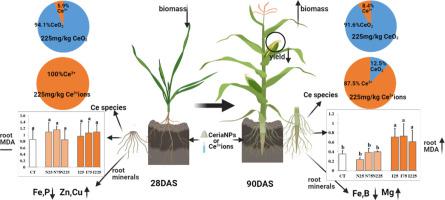NanoImpact ( IF 4.7 ) Pub Date : 2021-03-26 , DOI: 10.1016/j.impact.2021.100311 Chaonan Dong 1 , Chunlei Jiao 2 , Changjian Xie 3 , Yabo Liu 3 , Wenhe Luo 2 , Shixian Fan 3 , Yuhui Ma 3 , Xiao He 3 , Aijun Lin 4 , Zhiyong Zhang 2

|
The release of toxic ions from metal-based nanoparticles (NPs) may play an important role in biological effects of NPs. In this life cycle study, physiological and biochemical responses of soil-grown corn (Zea mays) plants exposed to ceria NPs and its ionic counterparts Ce3+ ions at 0, 25, 75 and 225 mg Ce/kg were investigated. Both treatments tended to reduce the fresh weight and height of the plants at 28 days after sowing (DAS), and delay silk appearance and finally decrease fruit weight at harvest. Uptake and distribution of some mineral nutrients, Ca, P, Fe, B, Zn and Mn in the plants were disturbed. None of the treatments significantly affected activities of antioxidant enzymes and MDA contents in the roots and leaves at 28 DAS. At 90 DAS, ceria NPs and Ce3+ ions disturbed the homeostasis of antioxidative systems in the plants, Ce3+ ions at all concentrations provoked significant oxidative damage in the roots and significantly increased MDA levels as compare to the control. The results indicate that the effects of ceria NPs and Ce3+ ions on corn plants varied with different growth stages and ceria NPs had similar but less severe impacts than Ce3+ ions. Speciation analysis revealed there was mutual transformation between CeO2 and Ce3+ in the soil-plant system. It is speculated that Ce3+ ions play a key role in toxicity. To the authors' knowledge, this is the first report of a life cycle study on comparative toxicity of CeO2 NPs and Ce3+ ions on corn plants.
中文翻译:

纳米二氧化铈和CeCl3对土壤中生长的玉米(Zea mays)植物生长及生理生化参数的影响
金属基纳米粒子 (NPs) 释放的有毒离子可能在 NPs 的生物学效应中起重要作用。在这项生命周期研究中,研究了土壤生长的玉米 ( Zea mays ) 植物在 0、25、75和 225 mg Ce/kg 下暴露于二氧化铈 NPs 及其离子对应物 Ce 3+离子的生理和生化反应。两种处理都倾向于在播种后 28 天(DAS)降低植物的鲜重和高度,并延迟丝绸的出现并最终降低收获时的果实重量。植物对某些矿物质养分Ca、P、Fe、B、Zn和Mn的吸收和分配受到干扰。在28 DAS时,没有一种处理显着影响根和叶中抗氧化酶活性和MDA含量。在 90 DAS、二氧化铈 NPs 和 Ce 3+离子扰乱了植物抗氧化系统的稳态,与对照相比,所有浓度的Ce 3+离子在根部引起了显着的氧化损伤,并显着增加了MDA水平。结果表明,二氧化铈NPs和Ce 3+离子对玉米植株的影响随生长阶段不同而不同,二氧化铈NPs与Ce 3+离子的影响相似,但影响较小。形态分析表明,CeO 2和Ce 3+在土壤-植物系统中存在相互转化。推测Ce 3+离子在毒性中起关键作用。据作者所知,这是关于 CeO 2比较毒性的生命周期研究的第一份报告。玉米植物上的NPs和Ce 3+离子。











































 京公网安备 11010802027423号
京公网安备 11010802027423号